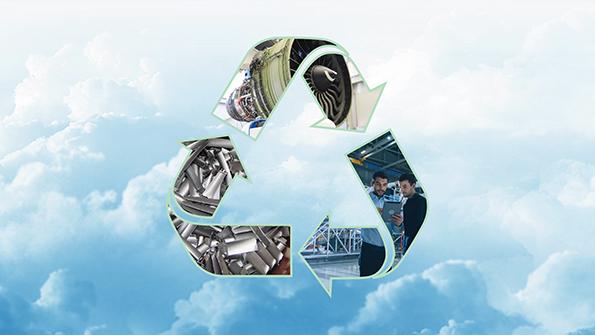
A few weeks before world leaders gathered in Glasgow for the Climate Summit in early November, sustainability was a key topic at the gathering of the aviation aftermarket industry at MRO Europe in Amsterdam.
Sustainability discussions during that event seemed to fall into two categories. One focused on how airlines are renewing fleets to include more fuel-efficient aircraft and their desire to use more sustainable aviation fuel (SAF) as they work toward net-zero carbon emissions goals by 2050. Secondly, aftermarket service providers stressed that MRO—maintenance, repair and overhaul—is synonymous with reduce, reuse and recycle.
HAECO Group has committed to zero net carbon by 2050 and hopes to move toward using SAF in its engine test cells, replacing diesel-powered vehicles with electric ones and using more renewable energy. “We have fairly aggressive targets to reduce our carbon emissions by 55% by 2035 as a midway point” of achieving the 2050 goal, Richard Kendall, HAECO Group’s chief commercial officer, said at MRO Europe.
Finnair set a goal to be carbon-neutral by 2045—earlier than most airlines—and get to half the net CO2 emissions goal by 2025, “so it’s steep at the beginning,” said Anne Larilahti, the airline’s sustainability vice president, speaking at MRO Europe. One step is zero net CO2 emissions from ground operations in 2022. Finnair also is working with vendors so its supply chain becomes more green, she said.
Air France-KLM Group committed to zero ground emissions by 2030, including its MRO operation (see this issue's cover story). Anne Brachet, AFI KLM E&M executive vice president, stressed that the MRO industry needs to measure what its impact is now and keep pushing for parts repairability. “We are doing a lot in terms of repair, but we could do much more within the industry. Part of the business model is based on new parts, but there is an issue here with sustainability,” she pointed out. “I really think we need to push for the reduction of new parts,” she stressed.
Brian Sartain, senior vice president at AAR, agreed about the need to measure output, which AAR is doing while converting its facilities to be more environmentally friendly, such as replacing incandescent lighting with digital systems and “measuring our solar-power usage as opposed to just taking power off the grid,” he said.
“We are the largest used serviceable material (USM) parts trader, at least in the U.S. and I think globally,” Sartain said. He predicts use of USM will grow as companies grapple with decreasing their footprints. That is why AAR is investing more in repair development and alternative parts than in the past.
For Finnair tech ops, Larilahiti said its biggest tool is similar to Weight Watchers: Set annual targets to reduce emissions, measure absolute and relative emissions and deliver on that.
And for each of us, little steps add up to big steps.
What projects and goals is your company pursuing, and how is it measuring them? I’d love to hear about them—please send me an email at leeann.shay@aviationweek.com.


